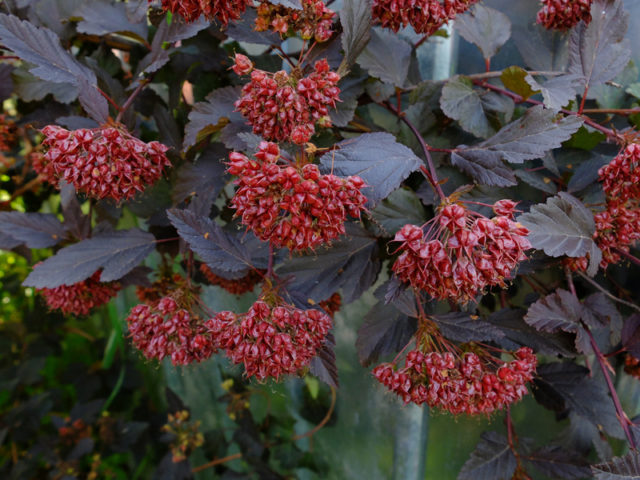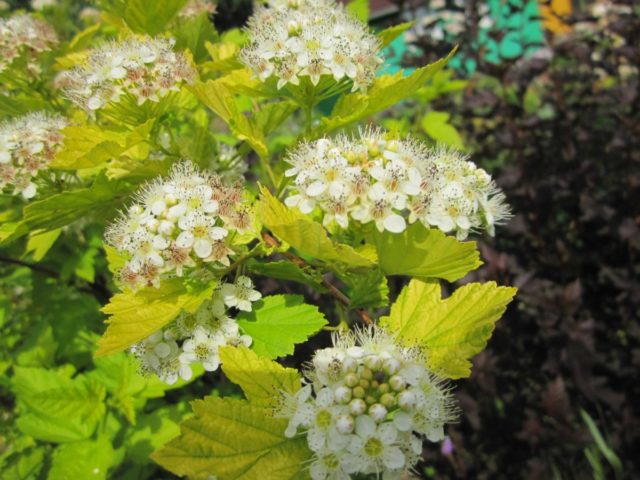Content
Pruning bladderwort in the fall is a common practice among gardeners. Caring for shrubs is simple, but requires certain requirements to be met. Recommendations for carrying out the pruning procedure and preparing the crop for winter are presented below.
Is it possible to prune bladderwort in the fall?
Autumn pruning of bladderwort is useful, but only after all the foliage has fallen. This is a sanitary and rejuvenating procedure that involves shortening branches, pruning old, diseased, damaged trunks and branches.
If the bush is planted as a hedge, it must be pruned at any time to give the desired shape to the crown. Trimming to create a certain appearance is necessary as young shoots grow. It is noteworthy that anyone can make a crown. Despite the predominance of rectangular low hedges, rounded, irregular shapes are achieved by trimming; it is permissible to use topiary art techniques.
In the fall, only the final procedure is carried out. The exception is the need to replant the plant.
How to prune bladderwort in the fall
Properly pruning the vesicle in the fall is simple; for this you will need:
- sharp tools - pruning shears, saw for thick branches;
- antiseptic for saw cuts, in order to avoid infection, it is advisable to use garden varnish;
- gloves that protect hands from microtraumas.
It is necessary to identify all branches of the vesicular carp that require removal, then proceed to the procedure. You should act carefully, avoiding damage to healthy shoots. In addition, cuts and cuts must be smooth, without chips or splits. The error can be corrected by making a cut or cut lower. It is prohibited to damage or remove the bark from the remaining branch of the vesicular carp.
Winter hardiness of bladderwort
The shrub has high winter hardiness. In central Russia, an adult bladderwort tolerates frosts without needing shelter. In the fall, it is advisable to mulch, add humus, peat, and straw. Insulated roots will increase the stability of the plant, and in the spring the shelter will play the role of feeding, ensuring health, good growth, and nutrition for the bladderwort.
In the Arctic Circle, it is advisable to insulate a plant (especially a varietal one), but varieties close to wild ones tolerate harsh winter conditions well. The main factor is snow covering the roots.
Young, recently transplanted specimens are more sensitive to cold than mature, healthy seedlings. It is necessary to pay close attention to the weather forecast and prepare the plant for wintering accordingly.
How to prepare bladderwort for winter
The bladderwort is undemanding in terms of care; in the fall, only minor preparation for winter will be required.After pruning in the autumn, you must:
- cover mature bushes together with young ones if a snowless winter is promised;
- make sure that the root system does not become damp; rot can destroy the planting;
- treat the bladderwort from pests;
- add fertilizer.
Bladderwort is often used as urban landscaping because... the culture requires little care and rarely gets sick.
How to cover a bladderwort for the winter
Plants of different ages are covered in different ways in the fall. An adult bush is insulated as follows:
- In late autumn, the plant is carefully tied with a rope.
- A cone of roofing material, a dense, non-woven covering material, is placed on top.
- The roots are insulated with mulch and spruce branches.
Such a need arises only under extreme weather conditions: little snow, frosty winter, spring frosts.
The young bladderwort is trimmed as much as possible, and the roots are also insulated. Then cover the cut bush with spruce branches. The spruce branches should be used dry, without traces of rotting or mold. The procedure is carried out annually until the plant reaches 4-5 years.
Caring for the bladderwort throughout the year
In the fall, the bladderwort needs more than just pruning. To ensure a quality winter for the shrub, you need to properly care for the plant throughout the year. A poorly overwintered crop may die in the spring or become vulnerable to parasites and diseases.
Transfer
It is advisable to replant the bladderwort at a young age, but it is also permissible to transfer adult bushes to another place.The procedure should be carried out in early spring (the buds should still be dormant) or in the fall, after the leaves have dropped.
Adult specimens do not tolerate transplantation well, but following the rules guarantees success and health of the bush. For a successful transplant you need:
- Carry out preliminary trimming. In addition to sanitary measures, all stems should be cut down to 0.2 m. This operation will increase the chances of survival of the transplanted specimen by reducing the load on the roots.
- Dig with the largest possible lump of earth. It is important not to clean off the soil; for better adhesion, it is advisable to lightly water the plant. Not enough soil on the roots will cause them to become damaged.
- Prepare a hole slightly larger than the size of the earthen ball. The soil left over from the preparation should not be disposed of. The material is useful for compacting free space.
- The transplanted bladderwort (in spring or autumn does not matter) is watered. It is advisable to use a solution of Kornevin or Heteroauxin. Fertilizers will strengthen the root system, which will allow the bush to be nourished better.
- When transplanting in spring, the leaves are sprayed with Ecogel-anti-stress after they appear; it is permissible to use Epin.
Watering and fertilizing
Even for an unpretentious vesicle, the humidity regime is important, especially for young or transplanted specimens. The composition of the soil also plays a role:
- On loam soils in hot climates, watering is necessary twice a week.Each adult bush requires 4 buckets of water.
- Clay soils require checking the moisture content not from above, but from within, so as not to over-moisten the soil. The root system dies when there is excess moisture.
- Sandy soils require regular watering, more than twice a week.
- Bushes growing in lowlands should be watered only after a long period of drought.
- On other soils, watering is carried out as the top layer of soil dries.
The bladderwort needs to be fed twice a year - in autumn and spring. Mineral fertilizers are applied in the fall, nitrogen-containing fertilizers (including organic) in the spring.
Mineral fertilizers (for example, nitroammophoska) are applied with a solution. One matchbox of the substance is diluted in 10 liters of water. An adult bladderwort will need 15 liters of solution.
In the spring they feed with a mixture of urea, ammonium nitrate, and mullein. Prepare a solution by adding to 10 liters of water:
- 1 tbsp. l. saltpeter;
- 1 tbsp. l. urea;
- 0.5 liters of mullein.
Mulching material serves as additional fertilizer. The amount of humus, peat or manure should be taken into account when planning fertilization in the fall.
Protection from diseases and pests
If the bladderwort is cared for correctly, pruned in a timely manner, the cuttings are processed, and fertilizers are applied, it shows good resistance to any pests and diseases.
A common problem with shrubs is chlorosis.The disease provokes drying of branches, especially the tops of stems, and premature yellowing of young leaves. The reason is lack of nutrition.
If signs of chlorosis are detected, it is necessary to spray the leaves (water the bush) with iron-containing fertilizers (Iron Chelate, Ferophyte, Ferrylene, Antichlorosis). After the disease has subsided, it is advisable to cut out the damaged branches and burn them away from the site. Additionally, it is recommended to observe for 1–2 weeks to ensure that chlorosis does not return. Relapses lead to the complete destruction of the bush.
Occasionally, a fungal infection may occur. The situation is only possible if the soil is waterlogged and the branches of the bush are damaged. The onset of rotting of the root system is especially dangerous. When powdery mildew occurs, diseased shoots are cut out and the bush is urgently transplanted to an elevated location in dry soil. Affected roots identified during inspection must be cut out.
There have been rare cases of attacks by parasites, such as the slobbering pennies. They spoil the appearance of the bush, but a simple treatment with an insecticide will help quickly eliminate the problem.
Conclusion
Pruning bladderwort in the fall is a necessary part of preparing the shrub for winter. It is permissible not to touch only young plants if there are no diseased branches. It is allowed to prune vesicular carp seedlings not in the fall, but immediately after flowering, in order to give the crown its shape.














